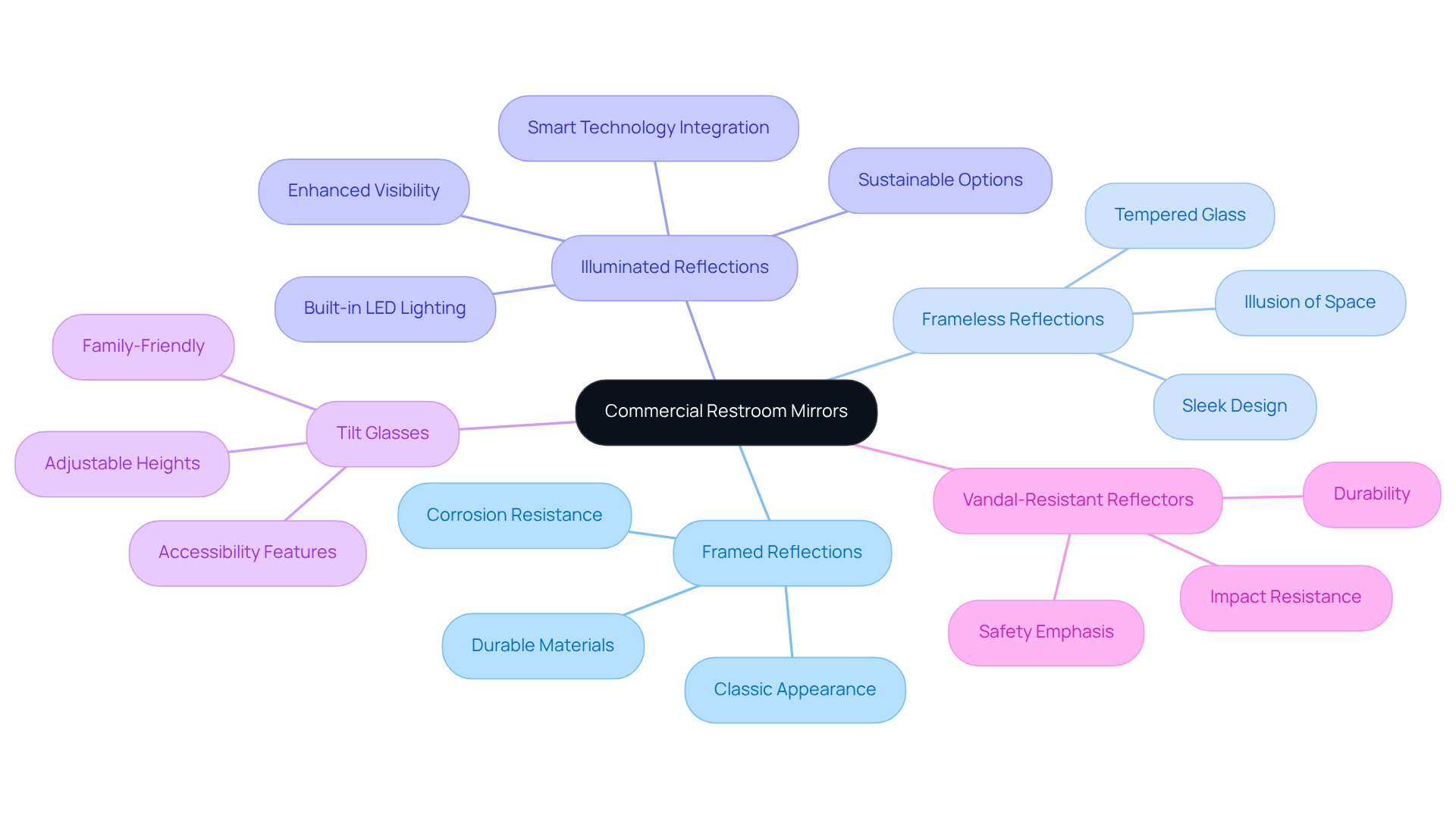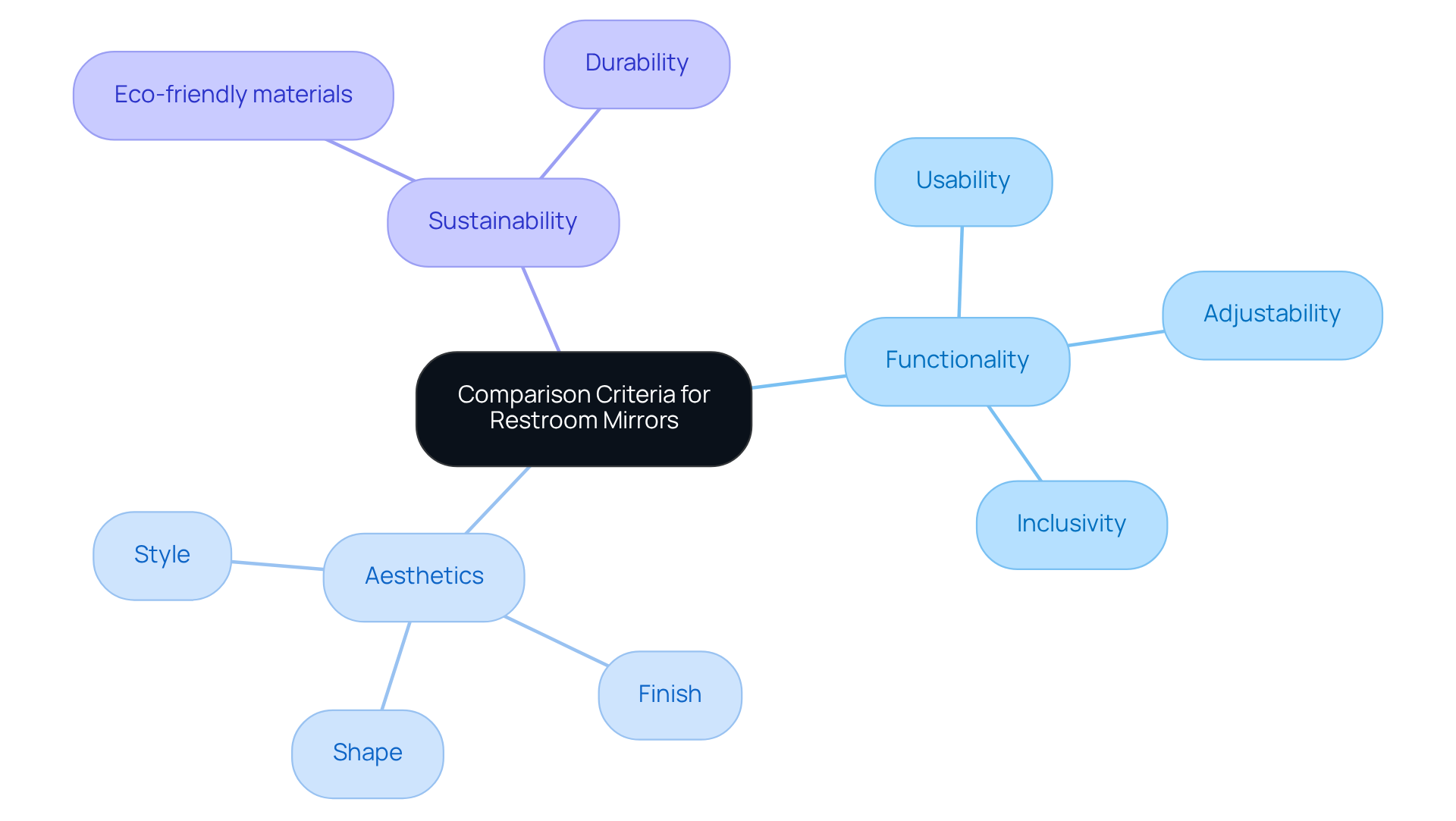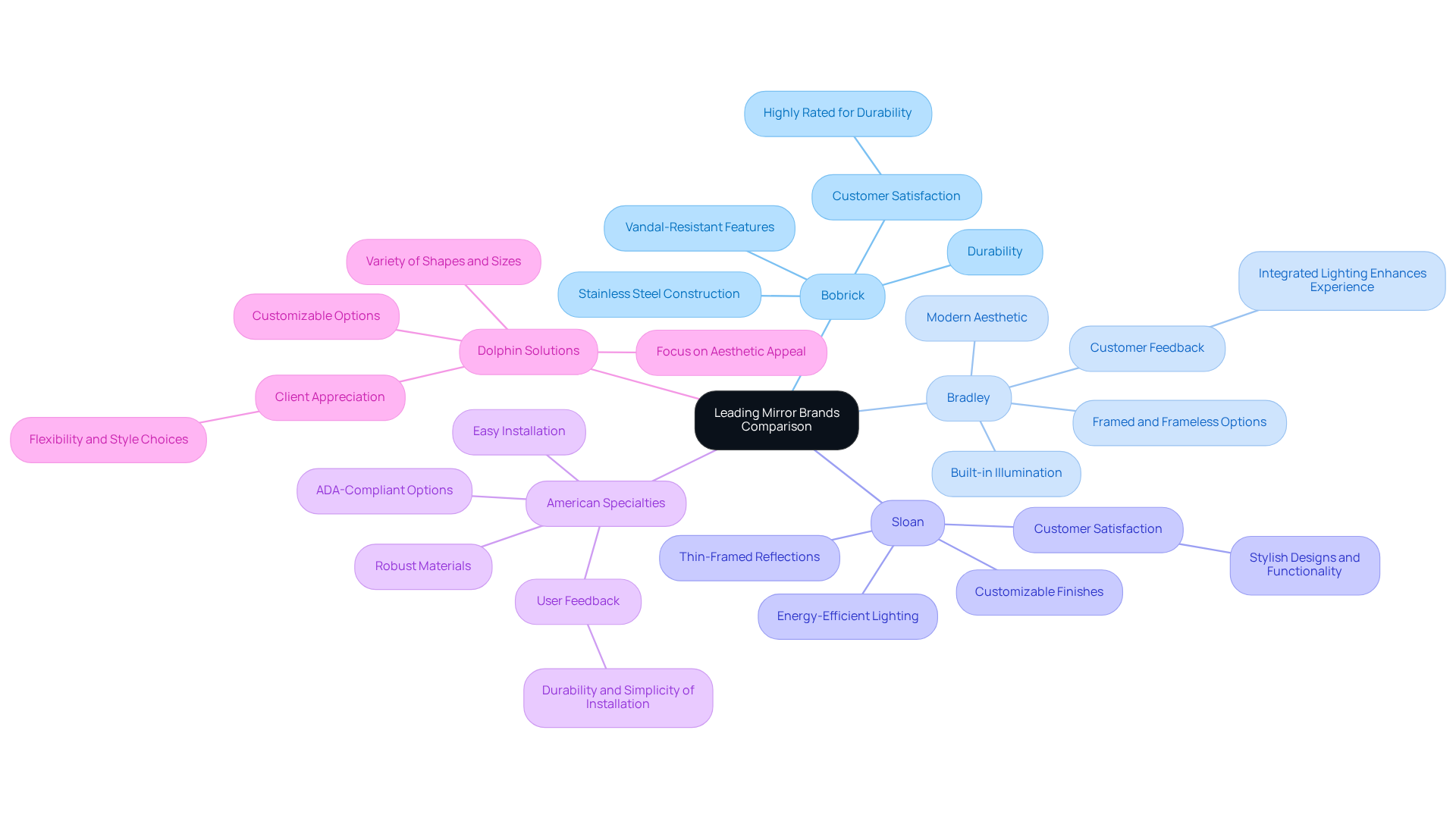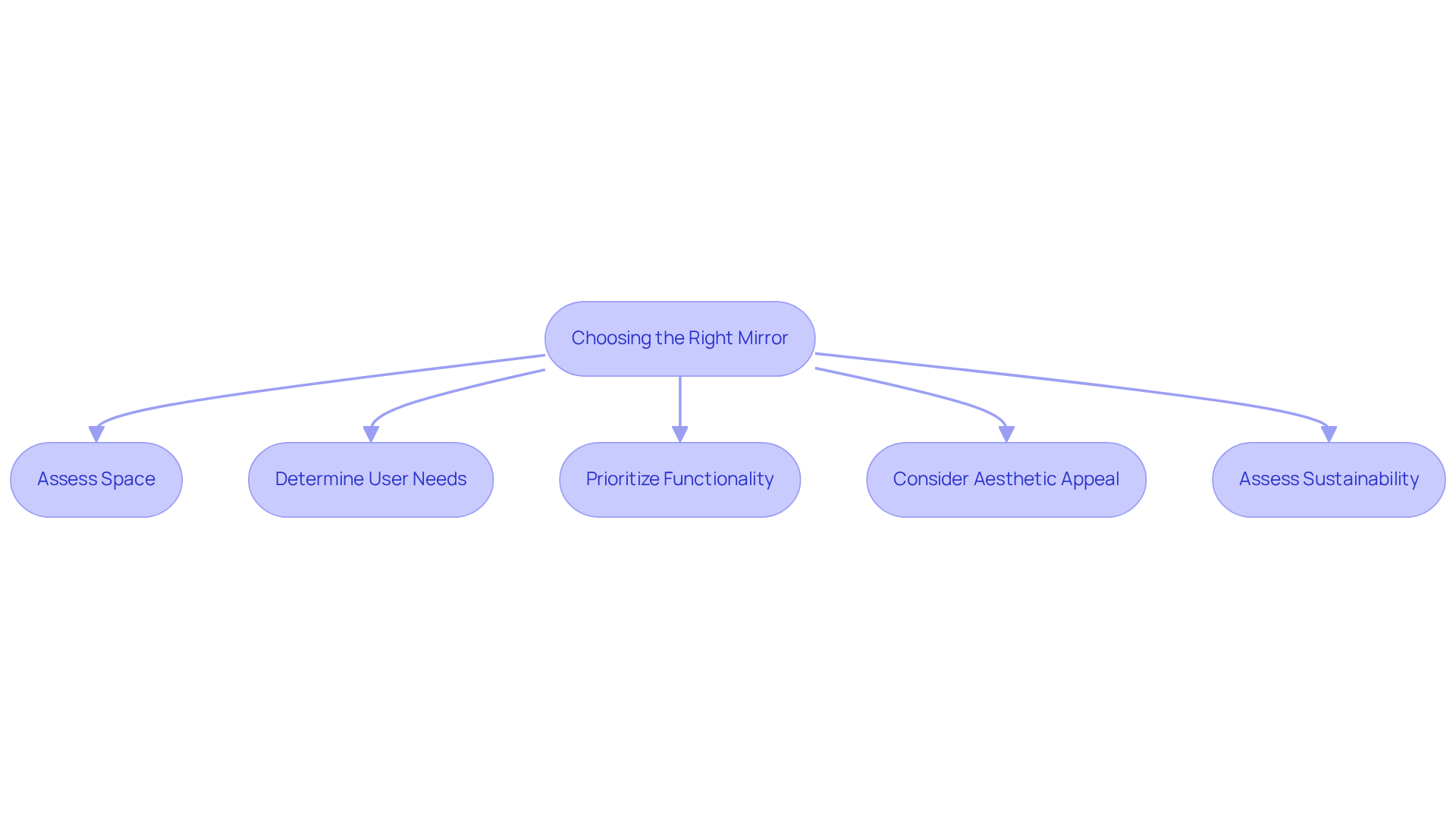Overview
This article provides a comprehensive overview of the various options available for commercial restroom mirrors, meticulously comparing their functionality and design to assist in selecting the most suitable type for high-traffic environments. It highlights five primary types of mirrors:
- Framed
- Frameless
- Illuminated
- Tilt glasses
- Vandal-resistant
Each type offers distinct advantages in terms of durability, aesthetics, and user experience. Furthermore, it underscores the critical importance of considering functionality, sustainability, and user needs throughout the selection process, ensuring that the chosen mirrors effectively meet the demands of their intended environment.
Introduction
The selection of commercial restroom mirrors transcends mere reflection; it embodies a commitment to enhancing functionality, aesthetics, and sustainability within high-traffic environments. With an array of options available—from framed and frameless designs to illuminated and vandal-resistant models—each type presents distinct advantages that can profoundly impact user experience.
As architects and facility managers navigate this varied landscape, they face the critical challenge of balancing practicality with design appeal. What criteria should inform their selection process to ensure that the chosen mirrors not only fulfill their intended purpose but also elevate the restroom's overall ambiance?
Overview of Commercial Restroom Mirror Options
Commercial restroom mirrors are essential components that enhance both utility and aesthetics in high-traffic environments. The primary types include:
- Framed Reflections: Encased in durable materials like stainless steel or aluminum, framed reflections offer a classic appearance and heightened resilience against corrosion and wear, making them ideal for bustling settings.
- Frameless Reflections: These pieces present a sleek, contemporary look and are typically crafted from tempered glass, creating an illusion of space that proves particularly advantageous in smaller bathrooms.
- Illuminated Reflections: Equipped with built-in LED lighting, these surfaces enhance visibility and cultivate a more inviting bathroom atmosphere, aligning with the trend toward sustainable options. The integration of intelligent technologies in illuminated reflective surfaces is increasingly popular, as they significantly elevate the user experience.
- Tilt Glasses: Adjustable for various individual heights, tilt glasses are perfect for family or accessible bathrooms, ensuring comfort and usability for all guests.
- Vandal-Resistant Reflectors: Designed to endure impacts and resist damage, these surfaces are vital in busy locations, emphasizing durability and safety.
Selecting the appropriate commercial restroom mirror can profoundly enhance the bathroom's utility and overall user experience. Statistics indicate that 82% of individuals prioritize touchless technology and practical aesthetics in bathrooms, underscoring the importance of thoughtful selection of reflective surfaces in modern restroom designs. Additionally, the trends projected for 2025 highlight innovative, eco-friendly, and tech-enabled solutions, which are critical considerations for architects and designers. Case studies from The Splash Lab, including projects for Padel Haus and Lacuna Space, illustrate successful applications of these reflective types, such as commercial restroom mirrors, in commercial environments, showcasing their commitment to quality craftsmanship and innovative design.

Comparison Criteria: Functionality, Aesthetics, and Sustainability
When evaluating commercial restroom mirrors, three essential criteria must be prioritized:
-
Functionality: This encompasses usability aspects such as visibility, adjustability, and features like integrated lighting or anti-fog technology. Ensuring that reflective surfaces accommodate everyone, including individuals with disabilities, is essential for improving the overall bathroom experience. As the trend towards gender inclusivity in facility design grows, functionality must also consider diverse individual needs.
-
Aesthetics: The visual influence of a reflective surface can significantly impact the bathroom's atmosphere. Components like shape, finish, and style should coordinate with the bathroom's decor, transforming the reflective surface into a potential focal point that enhances user experience. Designers are increasingly acknowledging that a well-crafted reflective surface contributes significantly to the overall aesthetic appeal of the space. As Brent Otsuka, Manager of Interior Design at Fentress Architects, aptly states, 'A well-selected reflective surface can act as a centerpiece in the bathroom, improving both functionality and aesthetics.'
-
Sustainability: As eco-friendly design becomes more common, the sustainability of materials employed in reflective surface production is vital. Options that incorporate recycled materials or energy-efficient lighting not only promote a greener restroom environment but also align with global conservation efforts. Furthermore, durability is a key factor; reflective surfaces that endure longer help minimize waste and reduce the need for frequent replacements. The growing focus on sustainability in interior aesthetics reflects a wider societal shift towards environmentally friendly practices.
By evaluating reflective surfaces, such as a commercial restroom mirror, according to these standards, architects and facility managers can guarantee their choices satisfy both practical requirements and design goals, ultimately improving the bathroom experience for all users. For instance, in the Lacuna Space project, the incorporation of sustainable materials and careful selection of elements exemplified how these criteria can be successfully implemented in a modern restroom setting.

Detailed Comparison of Leading Mirror Brands and Models
In this section, we provide a comprehensive comparison of several leading brands and their popular commercial restroom mirror models.
-
Bobrick is renowned for its sturdy stainless steel reflective surfaces, offering a variety of options, including the B-165 series. This series features a channel frame design that enhances durability, making these commercial restroom mirrors especially suitable for high-traffic areas due to their vandal-resistant characteristics. This guarantees durability even in challenging environments. Industry leaders commend Bobrick for its dedication to quality, with many noting that its stainless steel products rank among the most durable in the market.
-
The Bradley 781 series stands out with both framed and frameless options, emphasizing a streamlined appearance that complements modern aesthetics. Many of their reflective surfaces feature built-in illumination, making them a preferred choice for contemporary bathroom layouts that prioritize both aesthetics and practicality. Success stories highlight how Bradley reflections, particularly the commercial restroom mirror, have been successfully integrated into modern restroom designs, enhancing both user experience and visual appeal.
-
Sloan’s thin-framed reflections combine elegance with practicality. Their MF series allows for customizable finishes and sizes, catering to various aesthetic preferences while maintaining a commitment to sustainability through energy-efficient lighting solutions. Customer satisfaction ratings indicate that Sloan products are well-received for their stylish designs and functionality.
-
American Specialties excels in providing a variety of ADA-compliant commercial restroom mirrors, ensuring accessibility for all users. Their models, such as the commercial restroom mirror, are crafted from robust materials and designed for easy installation, establishing them as a reliable option for diverse washroom environments. User feedback emphasizes the simplicity of installation and the durability of American Specialties products.
-
Dolphin Solutions is recognized for its customizable options in creating commercial restroom mirrors, focusing on aesthetic appeal without compromising durability. Their commercial restroom mirror surfaces are available in a variety of shapes and sizes, making them adaptable for numerous restroom settings. Clients appreciate the flexibility and style choices offered by Dolphin Solutions.
Each brand presents unique advantages in the market, and understanding these distinctions is crucial for designers aiming to select the most suitable commercial restroom mirror for their projects. Customer satisfaction ratings reveal that Bobrick products are particularly favored for their durability, while Bradley’s integrated lighting features are highly esteemed for enhancing user experience in contemporary designs. This comparative analysis serves as a valuable resource for architects and designers striving to make informed decisions in bathroom layout.

Choosing the Right Mirror for Your Commercial Restroom Design
Choosing the right commercial restroom mirror for a restroom design requires careful consideration of several key factors.
First, assess the space. Evaluate the bathroom's size, layout, and overall design theme. Consider how the reflective surface will fit within the space and whether it will enhance or detract from the existing decor.
Next, determine user needs. Identify the primary users of the facility and their specific requirements. For instance, if the bathroom will serve families or individuals with disabilities, a commercial restroom mirror featuring adjustable or ADA-compliant reflective surfaces, such as those from Gamco's FT Series, is essential to ensure accessibility and comfort.
Furthermore, prioritize functionality. Select a commercial restroom mirror that offers optimal functionality for its intended use. Features such as anti-fog coatings, integrated lighting, and durability should be prioritized based on the facility's traffic and usage patterns. For example, Sloan's architecturally refined reflective surfaces deliver a cohesive appearance while ensuring high durability in busy environments.
In addition, consider the aesthetic appeal of the commercial restroom mirror. Choose a reflective surface that enhances the bathroom's design. The frame style, finish, and shape should align with the overall aesthetic vision—whether modern, classic, or minimalist—thereby enhancing the space's visual appeal. Custom frameless reflections from One Day Glass can elevate elegance and individuality in any bathroom, particularly when incorporating a commercial restroom mirror.
Lastly, assess sustainability. Opt for reflective surfaces crafted from sustainable materials or those that incorporate energy-efficient technologies. This choice not only benefits the environment but also attracts eco-conscious individuals, aligning with contemporary principles in washroom design. For instance, reflective surfaces that utilize copper-free glass are recommended for high-moisture areas, promoting sustainability and durability.
By thoughtfully evaluating these elements, designers and facility managers can select commercial restroom mirrors that meet functional needs while enhancing the overall bathroom experience. This approach contributes to customer satisfaction and favorable perceptions of the establishment. Case studies, such as those for Padel Haus and Lacuna Space, illustrate how strategic mirror selection can significantly enhance restroom environments and effectively meet user needs.

Conclusion
Selecting the right commercial restroom mirror is essential for enhancing both functionality and aesthetics in public facilities. The diverse options—spanning framed and frameless reflections to illuminated and vandal-resistant models—offer unique advantages tailored to different environments and user needs. By understanding the distinctions among these types, one can make informed choices that significantly enhance the user experience in high-traffic restrooms.
Key considerations encompass functionality, aesthetics, and sustainability. Functionality ensures that mirrors fulfill practical roles, such as visibility and accessibility, while aesthetics transform them into focal points that elevate the bathroom's design. Sustainability, increasingly vital in today's design landscape, necessitates materials and technologies that minimize environmental impact. The case studies presented in this article illustrate how thoughtful mirror selection can effectively meet these criteria, showcasing successful implementations across various commercial settings.
Ultimately, the choice of a commercial restroom mirror should reflect a commitment to quality, user comfort, and eco-friendliness. As trends lean towards more innovative and sustainable designs, architects and facility managers are encouraged to prioritize these elements in their selections. By doing so, they not only enhance the restroom environment but also contribute to a broader movement towards responsible and aesthetically pleasing commercial spaces.
Frequently Asked Questions
What are the main types of commercial restroom mirrors?
The main types of commercial restroom mirrors include Framed Reflections, Frameless Reflections, Illuminated Reflections, Tilt Glasses, and Vandal-Resistant Reflectors.
What are Framed Reflections?
Framed Reflections are mirrors encased in durable materials like stainless steel or aluminum, offering a classic appearance and increased resilience against corrosion and wear, making them suitable for high-traffic areas.
What advantages do Frameless Reflections provide?
Frameless Reflections present a sleek, contemporary look and are typically made from tempered glass, creating an illusion of space that is particularly beneficial in smaller bathrooms.
How do Illuminated Reflections enhance the bathroom experience?
Illuminated Reflections come with built-in LED lighting, improving visibility and creating a more inviting atmosphere in the bathroom. They also align with the trend toward sustainable options and often incorporate intelligent technologies.
What are Tilt Glasses and their benefits?
Tilt Glasses are adjustable mirrors designed for various individual heights, making them ideal for family or accessible bathrooms to ensure comfort and usability for all guests.
What are Vandal-Resistant Reflectors?
Vandal-Resistant Reflectors are designed to withstand impacts and resist damage, emphasizing durability and safety in busy locations.
Why is the selection of commercial restroom mirrors important?
Selecting the appropriate commercial restroom mirror can significantly enhance the bathroom's utility and overall user experience. Statistics show that 82% of individuals prioritize touchless technology and practical aesthetics in bathrooms.
What trends are projected for commercial restroom mirrors by 2025?
Trends projected for 2025 highlight innovative, eco-friendly, and tech-enabled solutions, which are essential considerations for architects and designers.
Can you provide examples of successful applications of these mirrors in commercial environments?
Case studies from The Splash Lab, including projects for Padel Haus and Lacuna Space, illustrate successful applications of various types of commercial restroom mirrors, showcasing their commitment to quality craftsmanship and innovative design.




